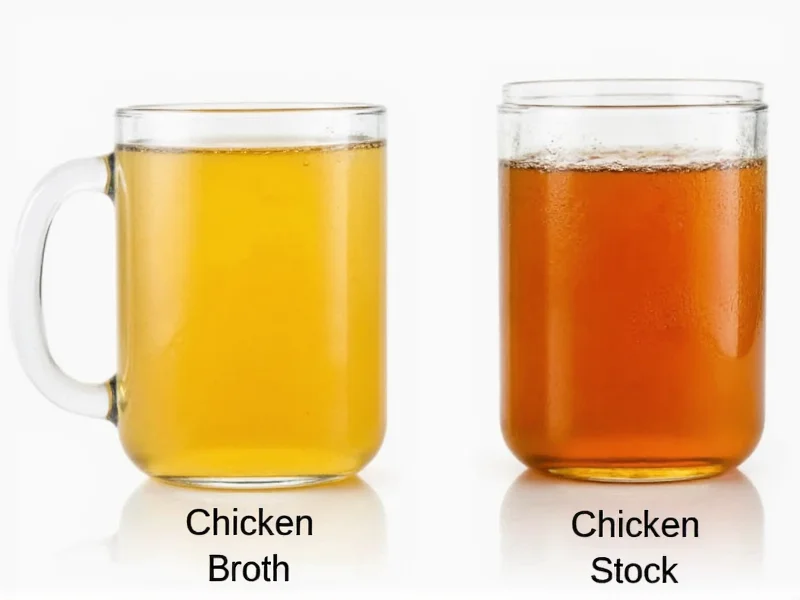Understanding the distinction between chicken broth and chicken stock is essential for home cooks and professional chefs alike. Though these terms are often used interchangeably in recipes and grocery stores, they represent two distinct culinary products with specific characteristics and best-use applications.
Defining Chicken Broth and Chicken Stock
At their core, both chicken broth and chicken stock serve as flavorful liquid bases for soups, sauces, and other dishes. However, their preparation methods create fundamental differences that affect texture, flavor concentration, and culinary functionality.
Key Differences Between Chicken Broth and Chicken Stock
| Characteristic | Chicken Stock | Chicken Broth |
|---|---|---|
| Primary Ingredients | Bones, connective tissue, cartilage | Meat, some bones |
| Cooking Time | 3-6 hours (sometimes longer) | 45 minutes to 2 hours |
| Texture | Gelatinous when cooled (due to collagen extraction) | Thinner, more liquid consistency |
| Flavor Profile | More subtle, neutral base flavor | Bolder, more immediately flavorful |
| Salt Content | Typically unsalted or lightly salted | Usually contains added salt |
| Nutritional Content | Higher in collagen, gelatin, minerals | Higher in protein from meat |
| Best Culinary Uses | Sauces, reductions, dishes requiring body | Soups, sipping, dishes needing immediate flavor |
Understanding the Preparation Process
The fundamental difference between chicken stock and chicken broth lies in their preparation. Chicken stock requires a longer simmering time—typically 3-6 hours—to fully extract collagen from bones and connective tissues. This extended cooking transforms collagen into gelatin, giving stock its characteristic rich mouthfeel and ability to gel when cooled.
Chicken broth, by contrast, focuses more on extracting flavor from meat rather than bones. The shorter cooking time preserves the more delicate flavors of the chicken meat while preventing the development of the strong, sometimes bitter notes that can emerge from prolonged bone simmering.
Practical Applications in Cooking
Knowing when to use chicken stock versus chicken broth can significantly impact your cooking results. Professional chefs often prefer stock as a base for sauces because its neutral flavor and gelatinous quality help create body and texture without overwhelming other ingredients. The gelatin in properly made stock also helps emulsify fats in sauces, creating a smoother, more cohesive final product.
Chicken broth works better when you need immediate flavor contribution, such as in simple soups or when serving a broth-based soup directly to diners. Many commercial "broths" are actually closer to stock in preparation but labeled as broth due to consumer familiarity with the term.
Can You Substitute One for the Other?
When considering whether you can substitute chicken broth for chicken stock or vice versa, the answer depends on your specific recipe and desired outcome. For most soups and stews, substitution works reasonably well, though you may need to adjust seasoning and cooking times.
When substituting chicken broth for stock in sauce-making, you might need to reduce the liquid longer to achieve proper consistency, or add a small amount of gelatin to replicate stock's thickening properties. When using stock in place of broth, you'll likely need to add additional seasoning since stock typically contains less salt and has a more neutral flavor profile.
Homemade Preparation Tips
Creating authentic chicken stock at home requires patience. Start with roasted chicken bones (leftover from a roast chicken works perfectly), add mirepoix (onion, carrot, celery), herbs, and enough cold water to cover. Simmer gently for at least 4 hours, skimming impurities that rise to the surface. The resulting liquid should have a rich golden color and form a gel when cooled.
For homemade chicken broth, use more meaty parts like chicken backs, wings, or even poached chicken meat. Simmer for 1-2 hours with vegetables and herbs. The shorter cooking time preserves the delicate chicken flavor while extracting sufficient taste from the meat.
Commercial Products: Reading Labels Carefully
When purchasing store-bought products, don't rely solely on the terms "broth" or "stock" on the label. Many manufacturers use these terms inconsistently. Check the ingredient list for clues:
- Products labeled "stock" that contain significant amounts of chicken meat are likely mislabeled
- "Broth" products with long ingredient lists including gelatin or additional thickeners may be attempting to mimic stock's properties
- Low-sodium options are preferable for both, as you can control seasoning in your final dish
Common Misconceptions Clarified
One widespread misconception is that chicken stock is simply a more concentrated version of broth. In reality, they're fundamentally different products created through different processes. Another common misunderstanding is that stock is always superior to broth—while stock has advantages for certain applications, broth serves important purposes where its lighter flavor profile is desirable.
Professional Chef Perspectives
Many professional kitchens maintain separate stocks and broths for different purposes. Stocks form the foundation of sauces and complex dishes where building layers of flavor is essential. Broths often serve as the base for finished soups or as a cooking liquid for grains like rice or quinoa where immediate flavor contribution is needed.











 浙公网安备
33010002000092号
浙公网安备
33010002000092号 浙B2-20120091-4
浙B2-20120091-4